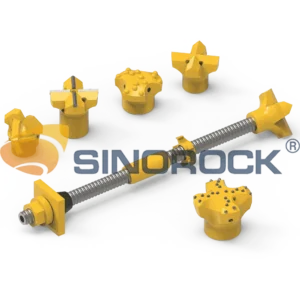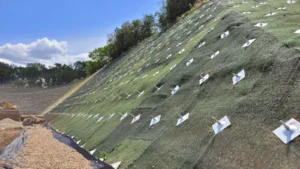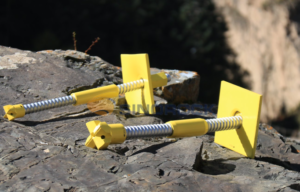The safety of slopes and surrounding infrastructure is critical in tunneling, road, and railway projects. Slope support has emerged as an indispensable component of such constructions, particularly in areas with challenging geological conditions. However, slope anchor drilling often encounters issues such as collapsed holes, drilling obstruction, and jamming, which can significantly disrupt progress and escalate costs.
This article delves into the primary reasons for slope anchor stuck drilling and outlines practical solutions to mitigate these challenges.
Understanding the Causes of Slope Anchor Stuck Drilling
1. Irrational Drill Bit Design
The design of the drill bit plays a pivotal role in the drilling process. Drill bits, along with rods, pads, and nuts, are integral components of anchor drilling systems. The geometric design of the drill bit, including its angles and structural integrity, determines its efficiency in cutting through rock and soil.
If a drill bit is not well-designed, issues such as poor drilling efficiency and obstructed slag discharge can arise. These problems stem from:
- Insufficient cutting angles leading to ineffective penetration.
- Inadequate slag discharge pathways that result in debris accumulation around the drill bit.
2. Excessive Drilling Speed
Drilling speed is a critical parameter that must be adjusted according to geological conditions. A high drilling speed can generate excessive axial force, causing debris to accumulate rapidly. This buildup leads to clogging, jamming, and potential damage to equipment.
3. Insufficient Drill Bit Torque
Torque is essential for efficient drilling. The mismatch between the torque requirements of geological formations and the drill bit’s capacity can result in stuck drilling. Factors influencing torque include:
- Drill bit diameter: Larger diameters increase torque demands.
- Material type: Harder formations require high-strength, heat-treated, or alloy bits.
4. Collapse Hole Shrinkage
Collapsible geological formations pose unique challenges. When using traditional casing drilling methods, withdrawing the drill pipe can cause the hole to collapse or shrink, trapping debris around the drill bit and halting further progress.
Effective Solutions for Slope Anchor Stuck Drilling
Addressing slope anchor jamming requires a combination of preventive measures and real-time adjustments during construction. Below are key strategies:
1. Control Drilling Speed
To mitigate jamming in collapsible formations:
- Use slower drilling speeds and rotational methods to reduce disturbances to surrounding rock.
- Periodically clear debris by withdrawing the drill and re-drilling.
- Monitor geological changes in real time to adjust speed dynamically.
2. Match Anchor Stiffness to Geological Conditions
In soft rock or mixed-layer formations:
- Choose anchors with appropriate stiffness to prevent bending or misalignment.
- Control rotary impact forces to ensure straight hole alignment and reduce the risk of jamming.
3. Optimize Slag Removal Processes
Efficient slag removal prevents debris accumulation that could block the drill bit. Depending on the geological conditions:
- Use water or air flushing techniques to clear debris.
- Regularly inspect slag discharge pathways to ensure they remain unobstructed.
4. Select Drill Bits with Appropriate Strength and Structure
Choosing the right drill bit can significantly enhance drilling performance:
- Use all-steel bits for soft soil or formations with high water content.
- Opt for alloy bits for hard rock formations with high UCS (Unconfined Compressive Strength) values.
- Ensure the bit’s structural design (e.g., spherical or cross configurations) matches the geological demands.
Industry Innovations and Best Practices
Advanced Drill Bit Design
Modern advancements in drill bit technology focus on improving efficiency and durability:
- Self-cleaning drill bits: These designs feature enhanced slag discharge pathways to reduce clogging.
- Material innovations: Composite and carbide bits are gaining popularity for their superior strength and wear resistance.
Real-Time Monitoring and Automation
State-of-the-art drilling rigs equipped with sensors allow real-time monitoring of torque, speed, and pressure. These systems:
- Enable operators to adjust parameters based on real-time data.
- Reduce the risk of stuck drilling by predicting and mitigating potential issues.
Tailored Construction Solutions
Custom solutions tailored to specific geological conditions are increasingly being adopted. Companies like Sinorock provide comprehensive packages that include:
- Geotechnical surveys to identify potential risks.
- Customized anchor systems designed to tackle unique challenges.
Key Benefits of Proactive Slope Anchor Management
Effective slope anchor management not only ensures safety but also improves overall project efficiency. The benefits include:
- Reduced Costs: Preventing stuck drilling minimizes equipment damage and delays.
- Enhanced Safety: Stable slopes reduce risks to workers and nearby structures.
- Improved Productivity: Efficient processes lead to faster project completion.
Sinorock: Your Trusted Partner in Slope Anchor Solutions
With extensive experience in addressing complex geological challenges, Sinorock stands at the forefront of slope support technology. The company offers:
- High-quality self-drilling anchor systems designed for collapsible and fragmented rock.
- Comprehensive support, from geotechnical analysis to customized solutions.
- Innovative products that enhance construction speed, safety, and cost-efficiency.
By choosing Sinorock, you can ensure that your slope engineering projects are completed on time, within budget, and to the highest standards of safety.
Conclusion
Slope anchor jamming is a common yet manageable challenge in tunneling, road, and railway construction. By understanding the causes and implementing effective solutions, construction teams can minimize disruptions, enhance safety, and reduce costs. Leveraging advanced technologies and expert support from industry leaders like Sinorock further ensures success in even the most challenging geological conditions.
Proactive planning, combined with innovative solutions, transforms slope support from a potential bottleneck into a streamlined process. Take control of your slope engineering projects today and build a safer, more efficient future.





